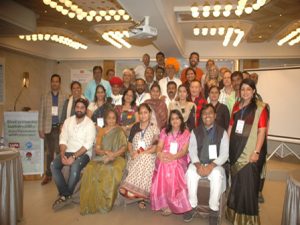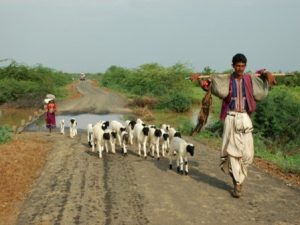Recognize Pastoralists and Their Stewardship in Environmental Sustainability
Despite their immense contribution to the national economic growth and sustainable development, pastoralists live in the peripheries of development. The SAPA conference highlighted some of their concerns demanding the attention of policy makers in the South Asian countries.

Livestock keeping is one of the major occupations in South Asian countries. For instance, herders and pastoralists contribute to 15 per cent of GDP in Afghanistan, 11.5 per cent in Nepal, 4.11 per cent in India and 2 per cent in Bangladesh. Despite millions of them scattered across the sub-region, pastoralists are never considered as a significant population. More often, pastoral communities are never enumerated in the national census. Consequently, their contribution to national economic growth, ecosystem conservation and nation-building were never recognized. This non-recognition kept them out of the ambit of the government’s welfare schemes leading to their poor socio-economic condition.
The South Asia Pastoral Alliance (SAPA) was formed in 2015 as a collaborative effort of pastoral communities in five South Asian countries to address these issues. SAPA aims to contribute towards the recognition of pastoralism, establishing pastoralists’ contribution to the sustainable ecosystem and protecting their tenure systems around rangelands. It pioneered the discourse of pastoralists at the South Asia level.
SAPA organized a conference on ‘Environmental Sustainability—Exploring Solutions within Pastoralism’ with the support from MARAG, International Land Coalition (ILC), Global Rangeland Initiative and JASIL. The conference was held from 29 to 30 January in Ahmedabad, India. Its objectives were to explore solutions, grab the attention of stakeholders and include pastoral issues in the larger discourse of development, environmental sustainability and climate change. The main thematic focus of the conference was on the contribution of pastoralists’ practices in sustaining the environment and climate change, especially exploring those related to pastoral women, the threat on commons property resources and its impact on the dependent community. Moreover, it also spoke about the policies that marginalize pastoralists in India and dispelling myths around pastoralism such as how pastoralists are accused as the main cause of rangeland degradation and how methane produced by their livestock contributes to climate change.
The conference had participants from eight countries such as Afghanistan, Argentina, Bangladesh, Italy, Kenya, Mongolia, Nepal and India. They included community representatives, activists, researchers and policymakers. Participants shared their stories, experiences and learning related to their struggles across the globe and their similarities and differences in overcoming the struggles. Good practices from Asia, Africa and Latin America were shared.
Also Read : Pastoralists Silent Battle For Survival
Participants shared how to use the international instruments/tools to safeguard the rights of pastoralists through the discussions on the Voluntary Guidelines on the Responsible Governance of Tenure of Land, Fisheries and Forests (VGGT), Sustainable Development Goals (SDGs) and the Declaration of International Year of Rangelands and Pastoralism (IYRP).
VGGT, for example, was recognized as a tool for improving governance of pastoral lands, recognizing customary practices and indigenous knowledge to ensure cultural and ecological diversity for resilience, strengthening the capacity of local organizations and foster collaborative learning. Participants reiterated that these tools could be used to address the knowledge gap and lack of recognition on rangelands and pastoralism.
Access to Land and Resources
During the discussions, some fundamental questions were raised as who should be called ‘original inhabitants’ and when an immigrant or refugee stops being migrant or refugee. These questions become crucial when the question of access and control over resources comes. While addressing these issues, original inhabitants get supremacy over resources.
In the current context, the issue of mobility needs to be understood in two perspectives. First, the historically migrating communities, which include pastoralists, and second, in recent times, the community that has been evolved due to the wage hunters and gatherers. These are the manufacturers of capitalism. This highlighted the issue of eminent domain versus the state control over resources. In the present scenario, the state has more control over natural resources, resulting in common property resources eroding quickly and increasingly privatized. It is because the value has been perceived by the lens of capitalism. The economic model of the state identifies and encourages the homogenous model to have settled and urbanized the way of life, whereas the pastoralist way of life is contrary to it. Therefore, there is a need for change in the attitude and policy of the government. It is not just a quest for another policy and legislation, but for a solution pertinent to the way of nomadic people, and which doesn’t force them to refrain from their traditional ways of life.
Pastoral Communities and Climate Change

The neoliberal and capitalist policies promote inequality in terms of access and usage of natural resources. They also contribute to the issues of climate change and environment degeneration. The learning is in the customary norms and practices of pastoralism, especially on managing and using rangelands. Pastoralists are the stewards of nature; they have a long history of co-existence with the farming community, tribal groups and wildlife in the forest. GIR National Park, the wildlife sanctuary of Gujarat, India, is a stark example of it. The pastoralists earlier used to live inside it, but in order to build the national park and protect the lions, they were forcibly evicted from the land they had lived. This resulted in degrading biodiversity of the land.
In recent decades, mobility of pastoralists has been curtailed by the establishment of political and administrative boundaries into rangelands, widespread industrialisation, eroding the control of traditional institutions and dismantling local practices. It is often ignored that the pastoralists have survived the changing climates and times and have demonstrated a history of co-existence.
The self-reliance of pastoralists is slowly shifting towards dependence on petty jobs as wage labours, housekeepers, etc. Dairy revolution in India has not helped the pastoralists. In fact, dairy cooperatives have reduced the independence and autonomous way of living of the pastoralists, which they enjoyed earlier.
“It is ironic how a litre of milk goes out from a village and comes back leaving behind a lot of carbon footprints,” said Lalji Desai, Founder, SAPA.
Pastoral Women as the Stewards of Our Planet
Women contribute to the sustenance of pastoralism in various ways. They access, use and manage rangelands judiciously. For example, they have rich knowledge of several types of grass with regard to its benefits in milk production and in making home remedies for the treatment of livestock. They make use of dung in regenerating rangelands and retain the water sources, especially in a time when water is becoming scarce. They are the key actors in maintaining the production system—milk production, making value-added products from milk and wool, besides excelling in marketing them.
Need for a National Policy
There was a consensus among all the participants of the conference that women can be the key agent in development strategies, rangeland management and climate change policies. It is necessary to make the role of women visible and promote such development programmes that ensure their full participation. After two days of deliberations, participants reiterated that there is a need for drafting an inclusive national policy on grazing land and pastoralists with special attention on pastoral women. It can be a worthwhile and effective step in giving recognition to women herders. The participants agreed to debunk myths related to pastoralism that they are responsible for methane emission, which could be made possible through scientific research and evidence-based advocacy.
Also Read : Secure Land Rights Critical For Asias Rural Communities Threatened By Covid 19
The census needs to enumerate the nomadic tribes and pastoralists in order to capture the accurate information regarding their numbers, economic condition, livestock holding, migration patterns and other related aspects. The database needs to be developed on the basis of pastoral knowledge and practices to inform the decision-making processes that affect their way of living. Pastoralists should also be encouraged to adopt new practices like changing their production flow, breeding practices, market responses, institutional-level changes, reliable data for quick response, capacity building of livestock keepers and livestock management.
Networking and collaboration of community-based organizations (CBOs) working for pastoralists’ need attention so that the ground realities can be brought to the notice of local administration. Encouraging dialogue with governments can help in addressing the specific needs of pastoralists who are crossing borders. Their access to health services and better veterinary services is imperative, while they are on the move.
Livestock intensification, at the cost of pastoralist systems as a mitigation strategy for climate change, has not been fully established. Thus, it requires further data and investigation to do a complete assessment. Comprehensive data is thus needed both in terms of animal/livestock enumeration under the different systems and of the landscapes they occupy.
Exchange of good practices will ensure that as a working group, participants can keep learning and improving their strategy as per the need of the community. All the participating countries also agreed to gather as much support as possible for IYRP to signify the importance of rangelands and pastoralists for global food security and sustainable environmental practices.
